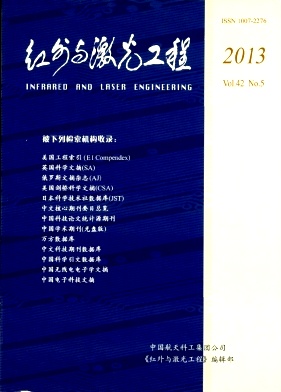Wang Hui, Lv Yingjie, Lin Defu, Zhang Di. Miss distance analysis of the extended trajectory shaping guided systems[J]. Infrared and Laser Engineering, 2013, 42(5): 1322-1329.
| Citation:
|
Wang Hui, Lv Yingjie, Lin Defu, Zhang Di. Miss distance analysis of the extended trajectory shaping guided systems[J]. Infrared and Laser Engineering, 2013, 42(5): 1322-1329.
|
Miss distance analysis of the extended trajectory shaping guided systems
- 1.
School of Aerospace Engineering,Beijing Institute of Technology,Beijing 100081,China;
- 2.
School of Aeronautic Science and Engineering,Beihang University,Beijing 100191,China;
- 3.
Qinghe Building Zi 6,Beijing 100085,China
- Received Date: 2012-09-21
- Rev Recd Date:
2012-10-24
- Publish Date:
2013-05-25
-
Abstract
The extended trajectory shaping guidance law was deduced based on the time-to-go weighted cost function. For the extended trajectory shaping guidance systems with one single lag seeker and autopilot dynamics, the non-dimensional position and angle adjoint models were derived using the non-dimensional technique and adjoint method when the seeker angular and angle zero position errors, angular noise and target glint noise was introduced into the guidance system. The simulation results show that in order to reduce the miss distance introduced by seeker angular zero position error, a large exponent n and long guidance time is necessary and when the missile terminal guidance time is about 15 times of the system total lag time, the position miss distance introduced by seeker angle zero position error approaches to zero while the angle miss distance approaches to an opposite value of the angle zero position error. With the increasing of the terminal guidance time, the position and angle miss of the seeker angular noise and target glint noise approaches to a nonzero stable value and the miss distance is increasing when the exponential number n increases. Finally, it will be seen that the miss distance introduced by angular noise is further increased with a slow guidance dynamics and with the increasing of the filter bandwidth, the miss distance introduced by glint noise is also increased.
-
References
|
[1]
|
|
|
[2]
|
Chang Chao, Lin Defu, Qi Zaikang, et al. Study on the optimal terminal guidance law with interception and impact angle[J]. Transactions of Beijing Institute of Technology, 2009, 29(3): 233-239. (in Chinese) |
|
[3]
|
Wang Hui, Lin Defu, Cheng Zhenxuan. Time-to-go weighted optimal trajectory shaping guidance law[J]. Journal of Beijing Institute of Technology, 2011, 20(3): 317-323. (in Chinese) |
|
[4]
|
|
|
[5]
|
Zarchan P. Tactical and Strategic Missile Guidance[M]. 5th edition, Virginia: AIAA Inc, 2007: 31-50, 541-569. |
|
[6]
|
|
|
[7]
|
Ben-Asher J Z, I Yaesh. Advances in Missile Guidance Theory[M]. Virginia: AIAA Inc, 1998. |
|
[8]
|
|
|
[9]
|
|
|
[10]
|
Ryoo C K, Cho H, Tahk M J. Optimal guidance laws with terminal impact angle constraint[J]. Journal of Guidance, Control and Dynamics, 2005, 28(4): 724-732. |
|
[11]
|
Ryoo C K, Cho H, Tahk M J. Closed-form solutions of optimal guidance with terminal impact angle constraint[C]// Proc IEEE Int Conf Control Application, Istanbul, Turkey, 2003: 504-509. |
|
[12]
|
|
|
[13]
|
|
|
[14]
|
Ohlmeyer E J, Phillips C A. Generalized vector explicit guidance[J]. Journal of Guidance Control and Dynamics, 2006, 29(2): 261-268. |
|
[15]
|
|
|
[16]
|
Garnell P. Guided Weapon Control Systems[M]. England: Pergamon Press, 1980: 248-290. |
|
[17]
|
|
|
[18]
|
Prasanna H M, Ghose D. Retro-proportional-navigation: a new guidance law for interception of high-speed targets[J]. Journal of Guidance Control and Dynamics, 2012, 35(2): 377-386. |
|
[19]
|
Wang Hui, Lin Defu, Qi Zaikang, et al. Study of time-varying optimal augmented proportional navigation and miss distance closed-form solutions[J]. Infrared and Laser Engineering, 2013, 42(3): 692-698. (in Chinese) |
|
[20]
|
|
|
[21]
|
Xu Ping, Wang Wei, Lin Defu, et al. Fluence of zero position error of angular rate on the precision of proportional navigation[J]. Infrared and Laser Engineering, 2011, 40(11): 2255-2260. (in Chinese) |
|
[22]
|
|
|
[23]
|
Wang Wei, Wu Kou, Xu Ping, et al. Laser semiactive seeker angular rate noise characteristics and its influence analysis[J]. Infrared and Laser Engineering, 2012, 41(9): 2370-2374. (in Chinese) |
|
[24]
|
|
|
[25]
|
Zhang Hong, Lin Defu, Qi Zaikang. Influence of radar guidance system noise on precision of guidance and control[J]. Journal of System Simulation, 2008, 20(5): 1295-1298. (in Chinese) |
-
-
Proportional views

-









 DownLoad:
DownLoad: